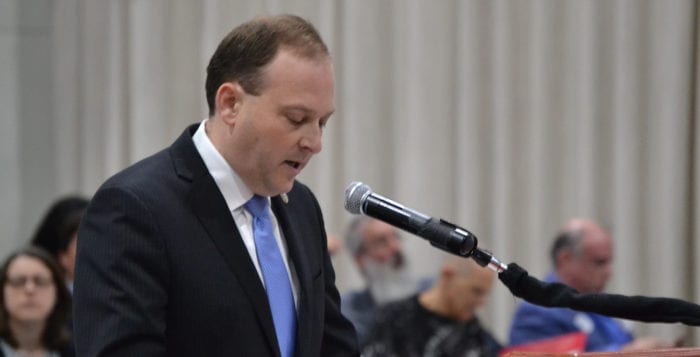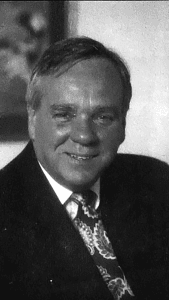Thousands of masks have come to Suffolk County over the past two days courtesy of the White House, both from purchases and donations.
After U.S. Rep. Lee Zeldin (R-NY1) put out a tweet asking for help for Suffolk County, where the number of positive diagnosis for COVID-19 continues to climb above 10,000, a member of the President Donald Trump (R) family connected with County Executive Steve Bellone (D). The county executive, who had run out of his supplies of personal protective equipment, purchased 150,000 surgical masks.
On Sunday night, Trump announced that he would ship 200,000 coveted n95 masks to Suffolk County, which came from a federal procurement collection, said Zeldin.
“For the n95 masks to come in without a charge helps all of those local entities laying out a lot of cash at the moment,” Zeldin said.
Zeldin is continuing to reach out to other resources around the country, hoping to secure hospital gowns, among other equipment. Indeed, Zeldin spoke earlier today with the Ambassador to Iceland, who is “working the phones to see if he can help the county procure gowns.”
The 1st district representative said he believes the timing of his tweet seeking assistance for Suffolk County “connected with Americans who may not even live in New York, but who were feeling the spirit as fellow Americans to do whatever they can.”
As for ventilators, Zeldin indicated that the White House is likely to respond to any requests for additional equipment with a question about the location and use of the 4,000 ventilators the federal government already sent.
“It appears [the ventilators from the federal stock pile] haven’t been deployed yet,” Zeldin said. “If you went back to the White House right now and said, ‘I need another ventilator,’ it would be a fair question to be asked back, ‘Where are the ventilators that we sent you?’”
Zeldin said he understands the plan at the state level to increase the number of ventilators as the state prepares for any sudden increase in demand, adding he wouldn’t expect the state to provide a map of where every ventilator is located, but he does believe an accounting of the life saving equipment would help the White House respond to any further requests.
Zeldin said putting together the location of ventilators in Suffolk County is, “something that [Bellone’s] office is working proactively on to identify. It appears that they know where every ventilator is in the county. They were working to obtain additional information beyond that and hopefully will yield some additional intelligence that helps in the process.”
Despite Gov. Andrew Cuomo (D) again today sharing he is optimistic New York could be hitting the apex of the virus, the number of cases on Long Island continue to grow as testing continues.
As of this morning, Bellone said the number of positive tests in Suffolk County for the virus had climbed to 13,487, which is an increase of over 1,000.
“We’re seeing a big increase in the number of people testing positive,” Bellone said.
The hospitalization rate, however, increased at a much slower pace than it had prior to Sunday as well. The number of people in the hospital with the virus stands at 1,463, which is up 26 patients, with 546 residents in the Intensive Care Unit, an increase of six patients.
“For the second day in a row, we’ve had a modest increase in the number of hospitalizations,” Bellone said “That is a good sign.”
Another positive piece of news, Bellone said, is that 63 people have left the hospital who had Covid-19.
These encouraging signs mean that the social distancing and New York Pause, which Cuomo extended until April 29, are working.
They do not, however, indicate that “we take our foot off the pedal,” Bellone said. “The worst thing is to see positive news and decide we can start adjusting our life back to normal. Then, we would see a rise in cases again and, instead of a plateau, we would go back up. We do not want to see that happen.”
As of today, Suffolk County had 710 hospital beds available, including 65 ICU beds.
The number of people who have died with coronavirus continues to rise. Bellone reported an additional 24 people who have died from complications related to coronavirus, which brings the total to 199. He expects those numbers may be under reported and the county may have crossed above 200 deaths.
Bellone continued to urge people who have recovered from a confirmed case of Covid-19 to donate blood plasma, which is rich in virus-fighting antibodies, to the Red Cross, to the New York Blood Center or to the Mount Sinai health system, which are available online at NYBloodCenter.org or MountSinai.org.
The Suffolk County Police Department continues to respond to calls about residents who are not complying with social distancing the New York Pause. Yesterday, the police department had 24 calls, of which three were non compliant. Once the officers spoke to those who were not compliant, they immediately changed their behavior and the officers didn’t have to issue any tickets.
Police Commissioner Geraldine Hart said some of those who were not complying with the ongoing social distancing rules have been in the hard-to-reach immigrant community. The police department is going out with signage and fliers. This morning, Hart participated in a radio show with La Fiesta “to make sure we’re communicating.” The police department has also reached out to community leaders to ask for their help.
To reach younger people who may not be complying, the police department has also used social media. Over the weekend, Hart partnered with school superintendents to do a robocall to ask families to follow the current public health mandates.






























